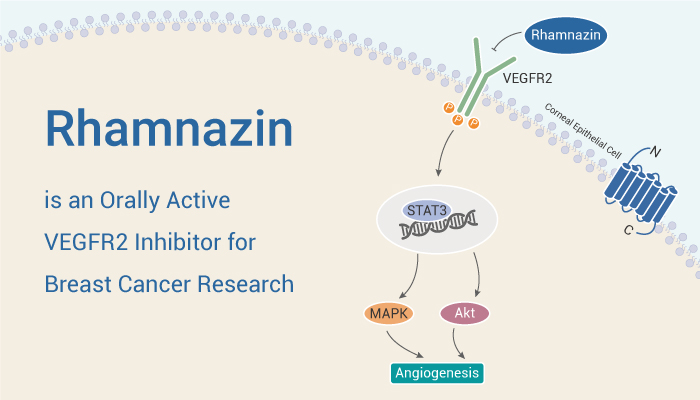Vascular endothelial growth factor (VEGF) and its receptor (VEGFR) play a crucial role in angiogenesis and angiogenesis. Specifically, the VEGF family includes VEGFA, VEGFB, VEGFC, VEGFD, and placental growth factor (PGF). Besides, the binding of VEGF to IgD2 and IgD3 of VEGFR-2 induces receptor dimerization. Subsequently, it induces the activation of tyrosine kinases and trans-self-phosphorylation and then initiates intracellular signaling cascades. Moreover, VEGF promotes the self-renewal of tumor-initiating cells through VEGFR2/STAT3 signal transduction. VEGFR plays an important role in regulating tumor-induced angiogenesis. Furthermore, VEGF can induce the internalization of VEGFR1 and VEGFR2.
Meanwhile, more and more evidence confirms that the abnormal expression of VEGFR2 in endothelial cells of neovascular tumors is closely related to the occurrence and development of various tumors. Structurally, the catalytic domain of VEGFR2 plays a crucial role in the inhibitory efficacy of these inhibitors as a double-leaf structure with small N leaves and large C leaves. Nonetheless, VEGFR-2 can form dimers even without VEGF. This receptor dimer is formed through contact between various parts within the cell and the regions embedded in the membrane. The expression of VEGFR2 in neovascular tumor endothelial cells is higher than that in normal endothelial cells. Importantly, VEGFR2 is a promising tumor treatment target. Inhibiting angiogenesis by blocking VEGFR-2 is an emerging strategy for developing selective and specific anticancer agents. Now, we will introduce an orally active inhibitor of VEGFR2 signaling, Rhamnazin.
Rhamnazin is an Orally Active VEGFR2 Inhibitor for Breast Cancer Research.

In the first place, Rhamnazin is an orally active inhibitor of VEGFR2 signaling with an IC50 of 4.68 μM against VEGFR2 kinase. Particularly, Rhamnazin shows potent antiangiogenic activity and antitumor efficacy. Rhamnazin shows antioxidant and anti-inflammatory properties.
In the next place, Rhamnazin inhibits the proliferation, migration, and tube formation of HUVECs induced by VEGF. Interestingly, Rhamnazin attenuates VEGFR-2 tyrosine kinase activity and the VEGFR-2 signaling pathway. Obviously, Rhamnazin inhibits the proliferation and VEGFR2 signaling pathway of breast cancer cells.
Last but not least, Rhamnazin with 200 mg/kg by i.g. daily for 25 days inhibits breast cancer growth and angiogenesis in mice. Additionally, Rhamnazin shows strong antioxidant and anti-inflammatory properties in the rat acute lung injury model.
All in all, Rhamnazin is an orally active inhibitor of VEGFR2 signaling for breast cancer research.
References:
Yu Y, et al. Biochem Biophys Res Commun. 2015 Mar 20;458(4):913-9.